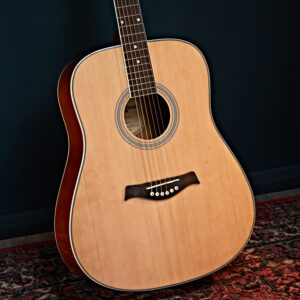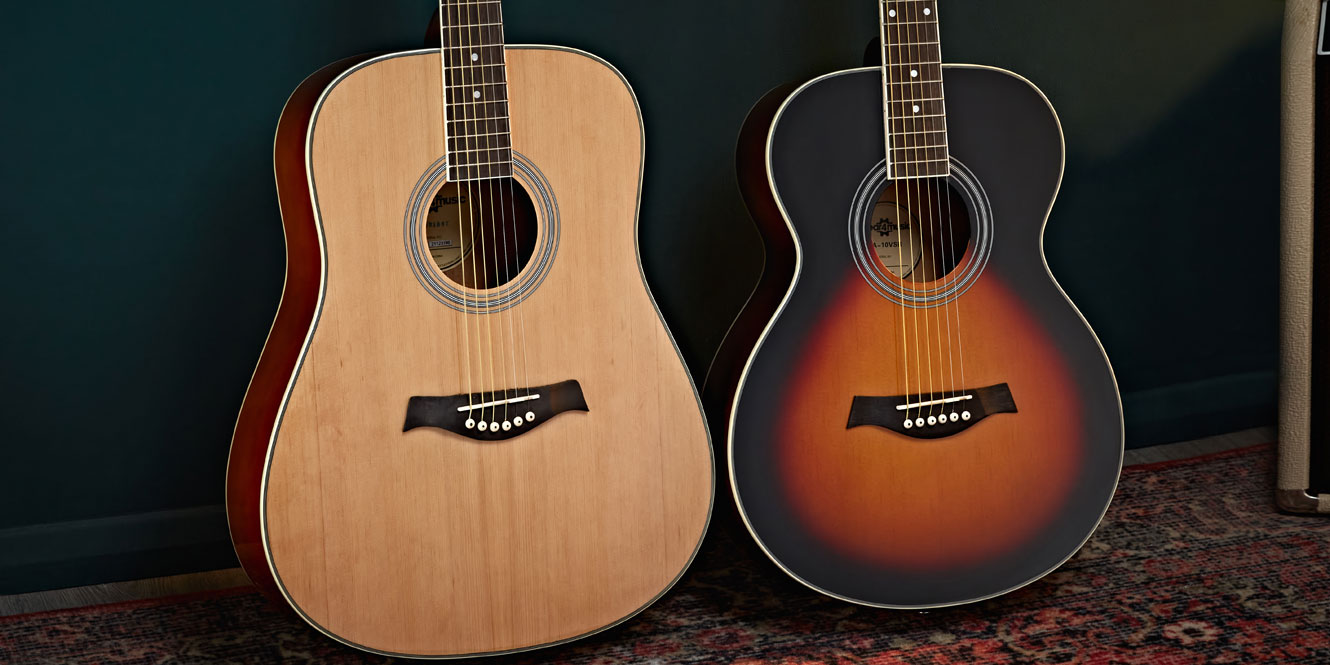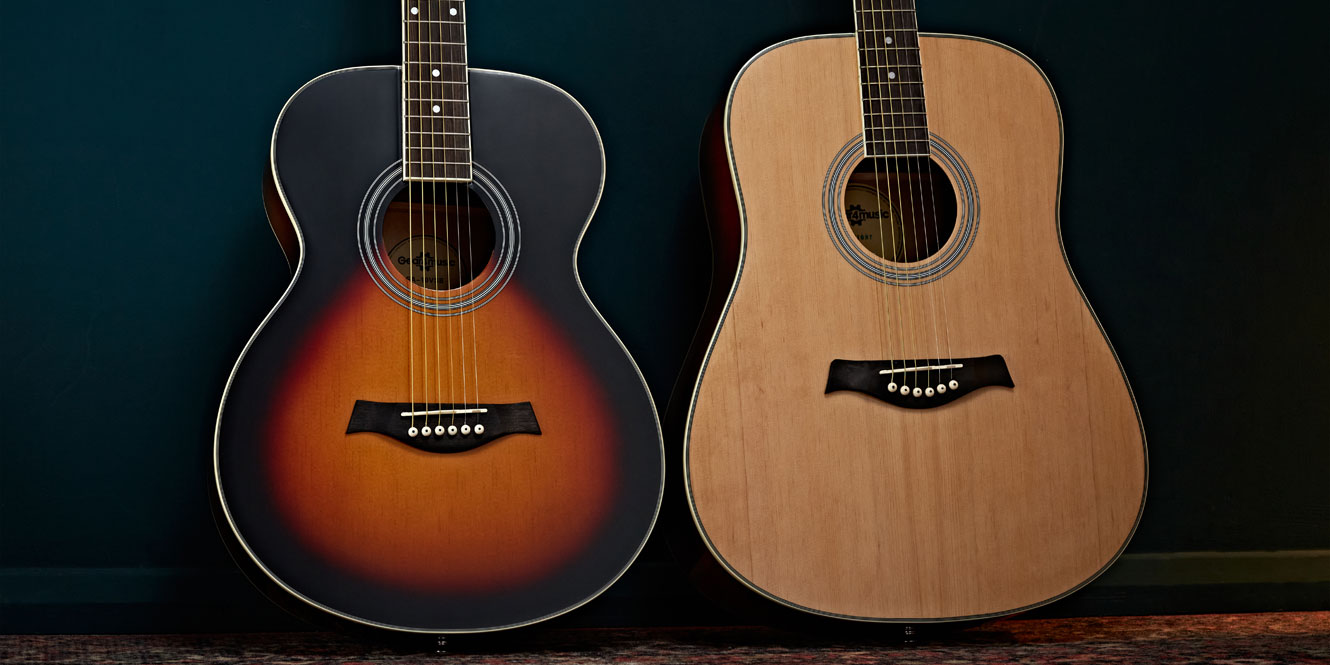The dreadnought and concert guitars are two of the most popular shapes in the acoustic market today. They might seem similar at a glance, and it can be hard to discern the differences between them, so to clear up any confusion, here’s our guide to dreadnought vs. concert guitars.
In this article, we’ll go over what types of genres, playing styles, situations, and playing levels each shape of guitar is best suited to. On top of all that, we have a few examples and suggestions to throw into the mix to help those just starting out.
Read on to find out more!
Main differences
Let’s start by charting out the primary differences between dreadnought and concert guitars:
| Feature | Dreadnought | Concert |
|---|---|---|
| Size | Larger body, typically 20" in length, 15-16" in width, and 4-5" in depth, with a scale length of 25.4" | Smaller, more tapered body, typically 18" in length, 13-14" in width, and 4-4.5" in depth, with a scale length of 24.7-25.5" |
| Tone | Bold, resonant, full-bodied | Brighter, more articulate |
| Playability | Can be challenging for smaller players | Easier for players of all sizes |
| Music Style | Great for strumming and fingerstyle | Versatile, suits fingerpicking well |
Dreadnought vs. concert
Dreadnought guitars
Size
 The dreadnought guitar boasts a larger body, typically measuring around 20 inches in length, with a width of about 15 to 16 inches and a depth of four to five inches. The scale length is usually 25.4 inches. This size provides a robust frame and a strong presence – as well as tonnes of volume!
The dreadnought guitar boasts a larger body, typically measuring around 20 inches in length, with a width of about 15 to 16 inches and a depth of four to five inches. The scale length is usually 25.4 inches. This size provides a robust frame and a strong presence – as well as tonnes of volume!
Tone
Known for its bold, resonant, and full-bodied tone, the dreadnought guitar fills a room with deep bass and powerful mid-ranges, making it a favourite among musicians looking for that rich sound.
Playability
Due to its size, the dreadnought guitar can be somewhat difficult for smaller guitarists or those with shorter reach. However, for advanced musicians or someone with a larger armspan, it can offer a comfortable, satisfying playing experience with plenty of space to fret and strum freely.
What style of music is the dreadnought suited to?
Perfectly suited to strumming and fingerstyle players, the dreadnought excels in genres that demand a commanding sound, such as country, rock, and folk.
Pros and cons of dreadnought guitars
| Pros | Cons |
|---|---|
| Rich, powerful sound | Size can be cumbersome for some |
| Great volume |
Concert guitars
Size
 Concert guitars feature a smaller, more tapered body that fits comfortably in your arms, making it ideal for players of all sizes. They typically measure around 18 inches in length, with a width of about 13 to 14 inches, a depth of four to 4.5 inches, and a scale length of 24.7 to 25.5 inches.
Concert guitars feature a smaller, more tapered body that fits comfortably in your arms, making it ideal for players of all sizes. They typically measure around 18 inches in length, with a width of about 13 to 14 inches, a depth of four to 4.5 inches, and a scale length of 24.7 to 25.5 inches.
Tone
These guitars produce a brighter, more articulate sound than the dreadnought. Their clarity makes them particularly great for genres that require intricate note work or when you need a bright voice to cut above an ensemble.
Playability
The smaller size and shape make concert guitars an accessible option to players of all ability levels, especially for those with smaller frames or who prefer a closer, more intimate playing experience. Their reduced stature can also make them more comfortable to play, making complex fingerstyle techniques that little bit easier.
What style of music is the concert suited to?
These guitars are incredibly versatile but shine in fingerpicking and softer genres, offering clarity and brightness that can articulate each note beautifully.
Pros and cons of concert guitars
| Pros | Cons |
|---|---|
| Comfortable size | Lower volume and bass response |
| Clear, bright tone |
Our dreadnought guitar recommendations
1. Dreadnought Acoustic Guitar by Gear4music
 Spruce top for a bright, articulate sound
Spruce top for a bright, articulate sound- Sealed chrome tuners and thermally treated bridge and fretboard increase sustain and tuning reliability
- Ergonomic C-shaped neck profile provides an easy-playing platform
If you’re looking for a dreadnought that’s packed with value and punches above its weight class, this Gear4music entry-level model is a superb choice. A spruce/basswood tonewood combo covers the whole frequency spectrum to give you a wide range of versatility when switching between genres.
For players looking for their first dreadnought, this Gear4music model’s C-shaped neck will make you feel right at home.
Electric guitarists and guitar novices will appreciate the ergonomic fit that’s easier to hold than classic chunky necks, while general playability enhancing features include a thermally-treated oiled fretboard and sealed chrome tuners.
Moreover, its low price point removes any barrier for both aspiring and experienced musicians looking to try out the dreadnought style.
2. Tanglewood TWBB SD E Blackbird Electro Acoustic
 All-mahogany body for rich, warm tones
All-mahogany body for rich, warm tones- Slope shoulder design and Smokestack Black colour give the Tanglewood a true vintage character
- Responsive Tanglewood electronics allow for easy amplification
The Tanglewood TWBB SD E Blackbird is where aesthetic meets functionality. This electro-acoustic features a mahogany top that ensures warm, rich tones, perfect for emotive playing.
Firmly in the budget category of acoustic guitars, Tanglewood boast a reputation for no-nonsense instruments that provide premium tones without the heft price tag. The Blackbird is no different, with its interesting aesthetics and imposing tones coming in at an entry-level cost.
The sloped shoulder design is the quintessential dreadnought classic and suits players looking for the authentic feel and 14th-fret neck joint, rather than a modern cutaway shape. Complemented by a sleek matte black finish and cream binding, it’s certainly easy on the eye and doesn’t cut back on style.
Most importantly, the Blackbird’s built-in electronics allow you to easily play live or record into a DI.
While you can expect plenty of volume when playing unplugged, there are times when you just want some extra oomph. The Tanglewood Premium Plus preamp allows you to connect to amps and PA systems with your natural acoustic tones intact – in addition to providing tone shaping and tuning options to keep your sound as tight as can be.
3. Martin D-28
 One of the most famous dreadnought-style acoustics
One of the most famous dreadnought-style acoustics- Incredible projection and rich, full sound offered by premium solid woods
- Martin’s X-bracing design and top-class appointments make this guitar stand out
Quite the jump from our other recommendations, the Martin D-28 represents the pinnacle of acoustic guitar craftsmanship. If you’re the type of player who thinks screw the rest – get the best then here it is!
The D-28 combines Martin’s heritage with contemporary playability and sound, with a design that’s changed little in over 100 years. As the company that invented the dreadnought shape, Martin guitars offer a character and authenticity like no other. And boy, do you pay for it.
The D-28’s considerable price tag is justified by its premium material selection that includes solid rosewood for the fingerboard and body, in addition to aesthetic elements like body and rosette bindings.
Combined with the precision labour of USA master luthiers, you get a guitar that boasts looks and sounds which are nothing short of incredible.
There’s no electronics to speak of with the D-28 as it maintains its vintage vibe, however, its rich tone is boosted in volume thanks to the sonorous qualities of its materials. Even playing unplugged you’ll be able to keep up with other instruments and percussion, offering clarity and power in every strum and pick. This guitar’s reputation is well-earned, making it a treasure for serious musicians and collectors alike.
Our concert guitar recommendations
1. Student Acoustic Guitar by Gear4music
 Compact size, ideal for learners
Compact size, ideal for learners- Warm, clear tone with a laminated spruce top
- Eye-catching vintage sunburst finish
The Student Acoustic Guitar by Gear4music is the perfect starter instrument for aspiring guitarists. Its compact concert shape makes it easy to handle and play, even for younger musicians.
The laminated spruce top delivers a warm, clear tone, ideal for practising chords and melodies, while a vintage sunburst finish adds a touch of classic style. It’s affordable and designed with beginners in mind, but that doesn’t mean it’s restricted to guitar newcomers!
The Student Acoustic is a great option for experienced players who want an inexpensive instrument with a bright voice that still retains plenty of volume.
It’s small and lightweight too, making it an ideal travel companion for taking to lessons and practice, or to the beach and camp when you’re feeling adventurous.
2. Takamine GF30CE FXC Electro Acoustic
 Solid spruce top for a bright, resonant sound
Solid spruce top for a bright, resonant sound- FXC body shape for comfort and versatility
- TP-4TD preamp for gig-ready performance
The Takamine GF30CE FXC Electro Acoustic combines Takamine’s renowned craftsmanship with the practical needs of modern players.
With a solid spruce top and FXC body shape, it produces a bright, clear tone and comfortable playability, suitable for a variety of musical styles. Interestingly, the shape isn’t your usual sloped shoulder concert style, but a funky cutaway with plenty of curves that’s quite eye-catching.
And while that shape sticks to the concert format, it’s a little more akin to a grand concert (ever so slightly wider on the lower bout) to produce stronger volumes and tones than narrower instruments.
The Takamine is a great all-rounder guitar that comes in at a price which allows for higher-end materials and technology yet doesn’t place it out of reach for most players. In addition, it’s designed to have a versatile voice that responds well to both fingerstyle and strumming.
With a slender neck that’ll feel comfortable and familiar to electric guitarists, and a responsive preamp system for easy live playing, the GF30CE is the choice for players that need a do-anything concert acoustic.
3. Taylor AD12e American Dream, Grand Concert
 Solid spruce top for crisp, articulate tones
Solid spruce top for crisp, articulate tones- Mahogany back and sides for warmth and resonance
- Revolutionary V-Class bracing for superior sound clarity
The Taylor AD12e American Dream is a concert-style acoustic that’s fit for touring pros and fresh beginners alike. This guitar sits on the higher end of the market but at a curious place within the Taylor range.
Their American Dream series gives you USA-made guitars at a more budget-friendly price, and this AD12e is the perfect example of that high-end craftsmanship. It’s packed with their industry-leading appointments like the V-class bracing, ES2 electronics, and solid walnut and spruce tonewoods (sourced from sustainable stocks).
Add to that Taylor’s oh-so-comfortable neck shape, and you’ve got a guitar that can compete with almost anything for both stage and studio.
What it sacrifices compared to other higher-end acoustics is things like a gloss finish and other aesthetic touches. But if you’re more focused on the tones than the image, then this is probably one of the best bang-for-buck options out there.
Dreadnought vs. concert – which one is for you?
When deciding between a dreadnought and a concert guitar, you need to be aware of your playing style and what guitar shape and size will help you perform well and comfortably. You should also consider the tone you’re aiming for.
Dreadnoughts are ideal for those who love a rich, powerful sound and often engage in strumming or fingerstyle play. They’re perfect for musicians who prefer a guitar that delivers a strong sonic presence. On the other hand, concert guitars are more suited to players looking for something easier to handle and a clearer, more articulate tone, especially beneficial for fingerpicking and genres that demand precision and clarity.
Choosing between dreadnought and concert guitars boils down to your personal preferences and musical needs. If you’re someone who enjoys the depth and volume in your music, the dreadnought will serve you well. However, if you value comfort and a nuanced sound, the concert might be your best pick.

FAQs
What is the difference between a concert and dreadnought guitar?
Concert guitars have a smaller body, offering a brighter tone and easier handling, ideal for fingerstyle. Dreadnoughts, larger in size, deliver a bolder, richer sound with more volume, perfect for strumming and versatile play.
What is the advantage of a dreadnought guitar?
Dreadnought guitars offer a powerful, rich tone with excellent volume, making them ideal for a broad range of musical styles. Their large body enhances bass response, perfect for strumming and dynamic performances.
Is a dreadnought guitar good for beginners?
Dreadnought guitars are quite large, meaning they can be quite difficult and uncomfortable to play for beginners. Their commanding presence in both size and tone makes them great for more advanced players.
Final thoughts
Looking at dreadnought vs. concert guitars, the right one for you comes down to size. The bigger your acoustic instrument is, the louder and bassier it will be, so it’s your personal preference on tone and playing style that matters the most.
Ultimately, it doesn’t have to be one type vs. the other! Many players will add both instruments to their arsenal to allow them to adapt to any genre or playing method. As we’ve seen in our recommendations, dreadnoughts and concerts don’t have to be expensive, so there’s plenty of room for those on smaller budgets to experiment with other types of acoustics.
Happy playing!














0 Comments